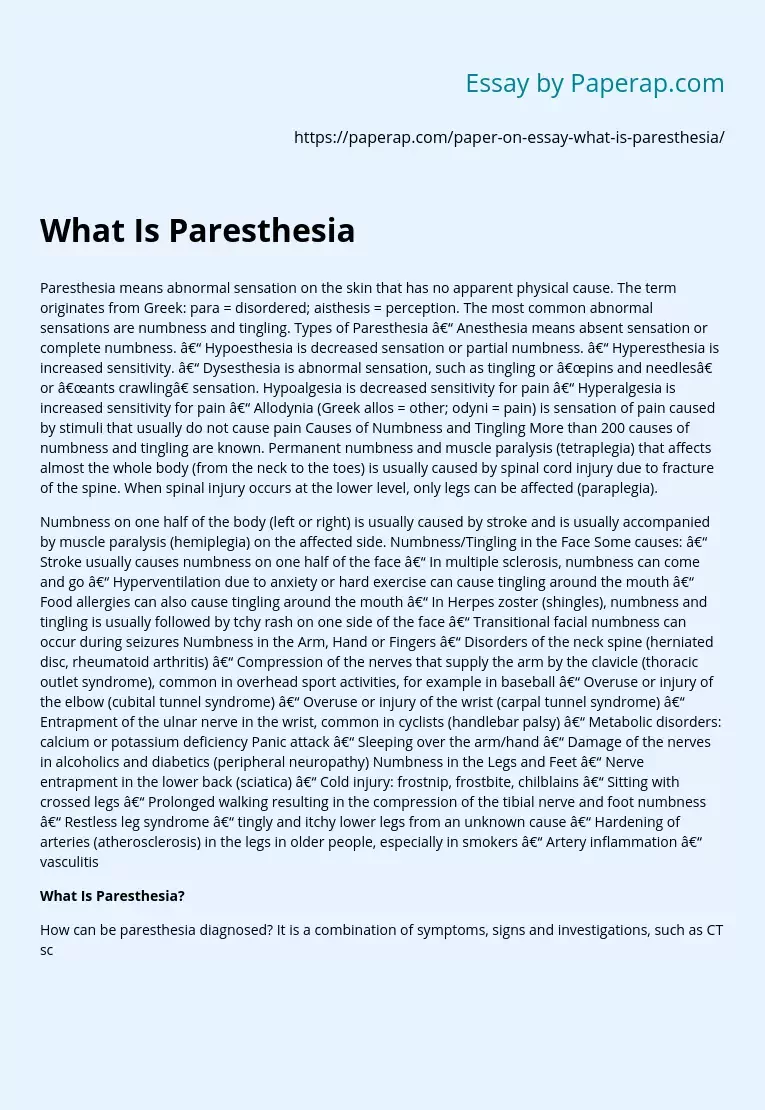What Is Paresthesia
Paresthesia means abnormal sensation on the skin that has no apparent physical cause. The term originates from Greek: para = disordered; aisthesis = perception. The most common abnormal sensations are numbness and tingling. Types of Paresthesia – Anesthesia means absent sensation or complete numbness. – Hypoesthesia is decreased sensation or partial numbness. – Hyperesthesia is increased sensitivity. – Dysesthesia is abnormal sensation, such as tingling or “pins and needles” or “ants crawling” sensation. Hypoalgesia is decreased sensitivity for pain – Hyperalgesia is increased sensitivity for pain – Allodynia (Greek allos = other; odyni = pain) is sensation of pain caused by stimuli that usually do not cause pain Causes of Numbness and Tingling More than 200 causes of numbness and tingling are known.
Permanent numbness and muscle paralysis (tetraplegia) that affects almost the whole body (from the neck to the toes) is usually caused by spinal cord injury due to fracture of the spine. When spinal injury occurs at the lower level, only legs can be affected (paraplegia).
Numbness on one half of the body (left or right) is usually caused by stroke and is usually accompanied by muscle paralysis (hemiplegia) on the affected side.
Numbness/Tingling in the Face Some causes: – Stroke usually causes numbness on one half of the face – In multiple sclerosis, numbness can come and go – Hyperventilation due to anxiety or hard exercise can cause tingling around the mouth – Food allergies can also cause tingling around the mouth – In Herpes zoster (shingles), numbness and tingling is usually followed by tchy rash on one side of the face – Transitional facial numbness can occur during seizures Numbness in the Arm, Hand or Fingers – Disorders of the neck spine (herniated disc, rheumatoid arthritis) – Compression of the nerves that supply the arm by the clavicle (thoracic outlet syndrome), common in overhead sport activities, for example in baseball – Overuse or injury of the elbow (cubital tunnel syndrome) – Overuse or injury of the wrist (carpal tunnel syndrome) – Entrapment of the ulnar nerve in the wrist, common in cyclists (handlebar palsy) – Metabolic disorders: calcium or potassium deficiency Panic attack – Sleeping over the arm/hand – Damage of the nerves in alcoholics and diabetics (peripheral neuropathy) Numbness in the Legs and Feet – Nerve entrapment in the lower back (sciatica) – Cold injury: frostnip, frostbite, chilblains – Sitting with crossed legs – Prolonged walking resulting in the compression of the tibial nerve and foot numbness – Restless leg syndrome – tingly and itchy lower legs from an unknown cause – Hardening of arteries (atherosclerosis) in the legs in older people, especially in smokers – Artery inflammation – vasculitis
How can be paresthesia diagnosed? It is a combination of symptoms, signs and investigations, such as CT scan or blood tests from which a doctor can make a diagnosis.
For example, an individual who had a stroke usually has a history of the event with lost consciousness, numbness and paralysis on one side of the body and a lesion in the brain, which can be seen on MRI or CT scan. How is paresthesia treated? Treating of the underlying cause usually cures paresthesia.
What Is Paresthesia. (2019, Dec 05). Retrieved from https://paperap.com/paper-on-essay-what-is-paresthesia/

